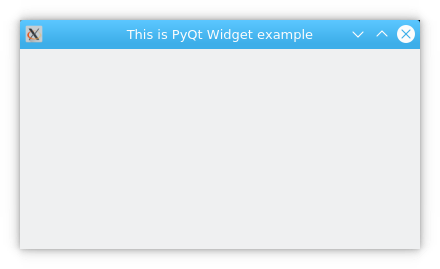

#INSTALL PYQT5 LINUX HOW TO#
Those who are familiar with the working of Linux would already know the installation process of Anaconda on WSL 1 or 2, however, the key thing is how to access its graphical user interface i.e Navigator.
#INSTALL PYQT5 LINUX INSTALL#
Run Anaconda Navigotr GUI on WSL Install Anaconda Navigator on WSL Ubuntu app for Windows 10 Due to the split of python3 and python2, using virtualenv to configure with pip, it is often very handy.ġ0. Once Anaconda is installed, python, conda, numpy, scipy, pandas, and other common scientific computing packages that may be used in general are installed, without the need to download the configuration separately. The installation of Anaconda is quite easy and those who don’t want to deal with the command-line interface to install packages, various dependencies, and create an environment it also offers the Graphical user interface called Anaconda Navigator… It supports Linux, Mac, and Windows systems, and can easily solve the coexistence, switching, and various third-party packages of multiple versions of Python. If you want to know about the Anaconda, it is essential software that has been developed to use with Python and other scientific packages and their dependencies, such as conda. However, if you still want to install it on the Linux interface that is running on WSL 1 or WSL 2 Linux Apps such as Ubuntu, then that is possible as well. Therefore, you will only need to install PyQt software, package manager.Here in this tutorial, we will learn the steps to install open source Anaconda Navigator on WSL- Windows Subsystem for Linux – Windows 10 using Ubuntu 20.04/18.04 Linux App.Īlthough Anaconda Navigator by default is available for Windows 10 in the executable file format.
#INSTALL PYQT5 LINUX MAC OS X#
For this software, it is not required to compile everything.įor Mac OS, you will need the Mac OS X binary, which will allow you to install PyQt on your terminal.įor Linux, you will discover that Python is installed by default. You can use this cross-platform on Windows by installing Python, and adding all the PyQt extras. It is a versatile method of coding, as it allows you to use several characteristics available with this framework. Those can be modified by clicking on them and changing their settings in the Property Editor.įrom this point on, you can mix and match a wide array of functionality related to Python and PyQt.

Keep in mind that the default functionality comes with two necessary buttons, OK and Cancel. You can drag from there any type of widget you desire and adapt them depending on your project. In the Qt Designer window, you will find a setting named Widget Box. Opt for Dialog with Bottom or the default option and press the create button. When you access Qt Designer, you should receive a dialog box prompting you to open a New Form.

Thus, you will need to design a Python script accordingly to the features you will want to have included in your finite product. After this, you will have to convert via PyQt, code in Python, and execute accordingly.Īfter creating the interface, you will have to create a building software, or a part bridging GUI to the business approach.


 0 kommentar(er)
0 kommentar(er)
